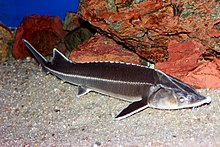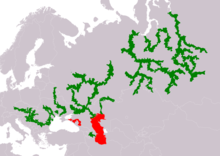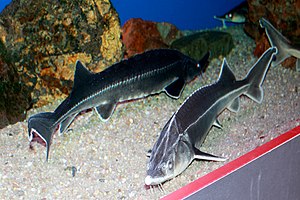Sterlet
| Sterlet | |
|---|---|

| |
| Scientific classification | |
| Domain: | Eukaryota |
| Kingdom: | Animalia |
| Phylum: | Chordata |
| Class: | Actinopterygii |
| Order: | Acipenseriformes |
| Family: | Acipenseridae |
| Genus: | Acipenser |
| Species: | A. ruthenus
|
| Binomial name | |
| Acipenser ruthenus | |

| |
| Range of A. ruthenus Resident Extinct
| |
| Synonyms[3][4] | |
|
List
| |
The sterlet (Acipenser ruthenus) is a relatively small species of
Due to
Physical appearance
- The sterlet may reach 16 kg in weight and 100 to 125 cm in length, rarely exceeding a length of 90 cm.
- It is quite variable in coloration, but usually has a yellowish ventralside.
- It is distinguishable from other European species of sturgeons by the presence of a great number of whitish lateral scutes, fringed barbels, and an elongated and narrow snout, highly variable in length.
Feeding habits
The sterlet's main source of food is

Life history

The sterlet commonly reaches the age of 22 to 25 years. Males reach sexual maturity at 3–7 years old and females at 4–12 years old. Spawning occurs from the middle of April to the beginning of June. Females may lay from 15,000–44,000 eggs, at water temperatures preferably 12–17 °C (54–63 °F).
As pond fish
Sterlets require relatively large ponds with good water conditions, and may get entangled in plants such as blanketweed. They may require special food such as sterlet sticks, as they are unable to digest the vegetable proteins usually found in commercial fish foods.[citation needed]
As food

In Russia, it is held in high esteem on account of its excellent flesh, contributing also to the best kinds of caviar and isinglass.[citation needed]
History in the Danube
The sterlet (Acipenser ruthenus in Linnaeus' classification) is the last of the five native sturgeon species inhabiting the Middle and Upper Danube River. Its population has dropped significantly, mainly due to the degradation of main habitats, spawning grounds and foraging grounds.[6]
References
- ^ a b c d e Gessner, J.; Freyhof, J.; Kottelat, M.; Friedrich, T. (2022). "Acipenser ruthenus". IUCN Red List of Threatened Species. 2022: e.T227A135062526. Retrieved 2 August 2022.
- ^ "Appendices | CITES". cites.org. Retrieved 2022-01-14.
- ^ Froese, R.; Pauly, D. (2017). "Acipenseridae". FishBase version (02/2017). Retrieved 18 May 2017.
- ^ "Acipenseridae" (PDF). Deeplyfish- fishes of the world. Retrieved 18 May 2017.
- ^ "What Do Sturgeon Fish Eat?". Sciencing. Retrieved 2022-04-29.
- ISSN 0175-8659.

